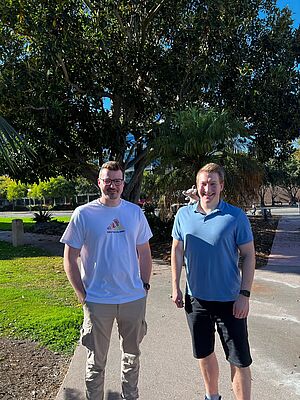Cryptography is the basis of digital security, safeguarding everything from bank transactions to private communications. Cryptographic encryption can be implemented either in software or directly in hardware, such as computer chips. However, the specific algorithms used are sometimes unknown due to corporate or security concerns. Identifying and analyzing cryptography in existing systems, especially in hardware, is extremely complex. The importance of this identification has been highlighted by the recent discovery of a deliberately engineered security flaw in the mobile standard GEA-1 by CASA researchers.
HAWKEYE Presented at IACR Crypto 2024
Identifying cryptography within chip circuits requires time-consuming hardware reverse engineering. Researchers from Bochum aim to transform part of this process with "HAWKEYE." Their paper "HAWKEYE – Recovering Symmetric Cryptography From Hardware Circuits," presented at the "44th Annual International Cryptology Conference" in Santa Barbara, USA, was developed within the interdisciplinary research project of the CASA Graduate School and in collaboration with the Max Planck Institute for Security and Privacy (MPI-SP). The project involved PhDs Lukas Stennes and Julian Speith, alongside CASA PIs Gregor Leander (Chair for Symmetric Cryptography) and Christof Paar (Founding Director MPI-SP).
The Spark for "HAWKEYE"
Julian Speith, a member of the Embedded Security Group led by Christof Paar, conceived the original idea for "HAWKEYE" and initiated the collaboration with Gregor Leander's Chair for Symmetric Cryptography. "The project was fascinating and provided a perfect opportunity for interdisciplinary exchange," states CASA PhD Lukas Stennes. To focus on the project, Stennes temporarily relocated to MPI-SP, a short distance from his office. "Being close to our project partners was invaluable. It enabled the intense collaboration necessary for this work," explains Stennes.
Graph Theory Identifies Encryption Elements
The research team developed a new approach to identify various encryption primitives embedded in computer chips. "HAWKEYE" can be applied to both Application-Specific Integrated Circuits (ASICs) and Field Programmable Gate Arrays (FPGAs) in programmable chips. The chip is regarded as a network of nodes and edges, represented as a directed graph. The challenge is to identify cryptographic primitives among the thousands of circuits. Using efficient graph algorithms, the system automatically analyzes circuit connections to identify potential encryption elements.
Faster and More Precise Than Traditional Methods
What distinguishes "HAWKEYE" is its focus on areas of the chip that perform highly local computations, rather than limiting itself to already known encryption such as S-boxes or round constants. The technique is optimized for SPN-, ARX-, and Feistel-based ciphers but can also identify other cryptographic algorithms.
The primary advantage over traditional methods or manual analysis is speed: Whereas conventional analyses can take weeks or months, "HAWKEYE" delivers results in seconds. “For example, analyzing the complex OpenTitan Earl Grey chip took just 44 seconds”, states Julian Speith.
In the future, the research team plans to enhance "HAWKEYE" to apply to shift-register-based cryptographic algorithms and implementations resistant to side-channel attacks. Another aim is to use "HAWKEYE" to identify previously unknown cryptographic algorithms —a significant step for the future of data security.
Infobox: Interdisciplinarity as a Core Value at CASA
Interdisciplinary collaboration is a fundamental principle at CASA and an outstanding feature of Bochum's research. All CASA PhDs spend at least six weeks in the research group of another CASA Principal Investigator. During this time, they work on an interdisciplinary project that advances their dissertation while leveraging the expertise of the respective Principal Investigator.
General note: In case of using gender-assigning attributes we include all those who consider themselves in this gender regardless of their own biological sex.


